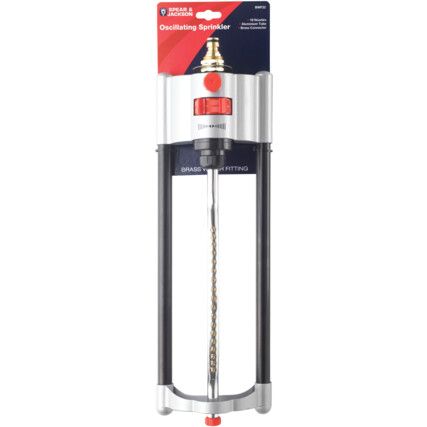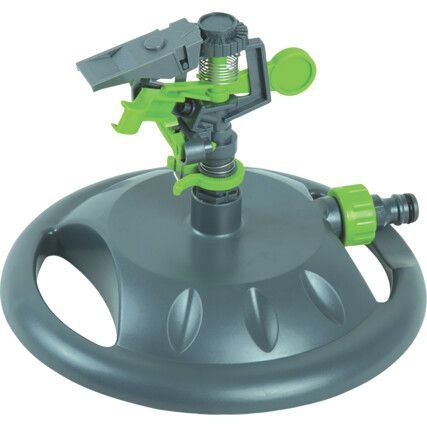Sprinklers
Where supplemental water is required for green lawns and healthy plants and crops, a lawn sprinkler is an irrigation solution chosen by many. Available in a range of designs to suit every budget, we stock a wide selection of lawn sprinklers to keep your garden healthy and green during the hotter months.
Choose from our selection of lawn sprinklers from well-known brands like Spear & Jackson® and Rutland®.
What is a lawn sprinkler?
A lawn sprinkler sprays jets of water onto lawns or planting borders. Domestic gardeners often use mains powered sprinklers that connect to an external water tap and spray every time they're turned on. Large estates and golf courses install complicated sprinkler systems into the ground to run along beds, borders and sprawling grass verges to automatically water according to a timer.
Why a lawn sprinkler?
Lawn sprinklers are a convenient way of covering large patches of grass or flower beds, with some sprinkler systems possessing the added benefit of being able to operate on a timer system to minimise user effort.
When to use a lawn sprinkler?
Lawn sprinklers are ideal for use on larger areas of lawn or areas that are particularly prone to drying out. They are most commonly used in the heat of the sumer months to keep lawns and plants healthy.
Lawn sprinkler types
Sprinklers come in a range of types and sizes to deliver varied spray patterns and coverage distance. Each have their pros and cons, and these must be considered when choosing the right sprinkler for the job. For example, an oscillating sprinkler will deliver heavy coverage, however it is also subject to wind changes and evaporation.
• Oscillating Sprinklers - Delivers wide fan-shaped spray and consistent coverage
• Impact Sprinklers - Uses water pressure to fire the spray in a circular pattern
• Fixed Sprinklers - Attaches to the mains and can be spiked or stationary
• Rotary Sprinklers - Feature two or three spinning arms that release water
• Pulsating Sprinklers - Features height, spray pattern, coverage and spray type controls
• In-ground Sprinklers - Large and expensive but deliver timed and consistent watering
Considerations when choosing lawn sprinklers
• Watering requirements - how much of your garden needs watering and what coverage you require from a sprinkler.
• Frequency - what is the amount of water required for the area and how many times (per day or per week) will the area need watering.
• Materials - the body of a sprinkler can be made from durable plastic or metal. A metal body can be heavy and difficult to move, which makes it an ideal material for a stationary sprinkler. Flexible spray nozzles are the best to help prevent blockages.
• Convenience - how easy it is to turn your sprinkler on and off is an important factor. A lot of sprinklers have the ON button located centrally on the body which will soak anyone who touches it, while others have a separate ON/OFF switch along with flow controls for convenient adjustment.
• Coverage - know the area you want to be watered and ensure the sprinkler you buy covers this area. Missed corners and edges can lead to patchiness in lawns or flower beds.
FAQs
How do I calculate how many sprinklers I need?
Measure the area you wish to water and use this information when choosing sprinklers. Some gardeners will move hose powered stationary sprinklers around to ensure maximum coverage. However, for multiple sprinklers consider the spray shape and the maximum distance they cover. Divide this by two and place your sprinklers at this distance apart from one another to ensure the best coverage.
Are sprinklers suitable for watering a large area?
Some sprinklers cover a large surface area and can be used in multiples on one patch. However, there are downsides to this approach, since to spray further the sprinkler must also spray higher. This means that spray can be affected by wind changes and can evaporate in warmer conditions.
Depending on the space, gardeners often install drip irrigation, which consists of microtubing laid across the ground. Tiny holes in the tubing release constant drips of water to ensure consistent irrigation with minimum evaporation.

